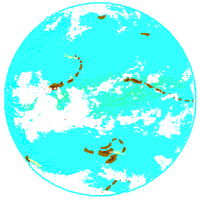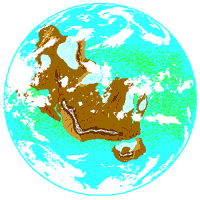|
The Precambrian Eon
The name means: "before the Cambrian period." This old,
but still common term was originally used to refer to the whole
period of Earth's history before the formation of the oldest rocks
with recognizable fossils in them. In the last few decades, however,
geologists have found that there are some hard-to-discern fossils
in some Precambrian rocks, so this period also is now known as the
Cryptozoic or "obscure life" Eon (from the words "crypt"
= "hidden," and "zoon" = "life").
This eon covers almost
90% of the entire history of Earth. It has been divided into three
eras: the Hadean, the Archean and the Proterozoic. Each era is very
different.
Hadean ("Hades-like")
Era (pictured above)
This era begins about 4.6 billion years ago with the formation of
Earth from dust and gas orbiting the Sun. During this era the surface
of Earth is like popular visions of Hades: oceans of liquid rock,
boiling sulfur, and impact craters everywhere! Volcanoes blast off
all over the place, and the rain of rocks and asteroids from space
never ends. It is hard to take a step without falling into a pool
of lava or getting hit by a meteor! The air is hot, thick, steamy,
and full of dust and crud. But you can't breathe it anyway: its
made of nothing but carbon dioxide and water vapor, with traces
of nitrogen and smelly sulfur compounds! Any rocks that do form
from cooling lavas are quickly buried under new lava flows or blasted
to bits by yet another impact. Some people think that an asteroid
as large as the planet Mars hit Earth near the beginning of the
Hadean era, completely smashing and melting Earth and forming the
Moon as part of the "splash!" Wow!
No one has found any
rocks on Earth from this era. Only meteorites from space and moon
rocks are this old. If any life formed on Earth during this era,
it was probably destroyed.
 Archaean
("Ancient" or "Primitive") Era Archaean
("Ancient" or "Primitive") Era
This era begins about a billion years after the formation of Earth,
and things have changed a lot! Mostly everything has cooled down.
Most water vapor in the air has cooled and condensed to form a global
ocean. Even most of the carbon dioxide is gone, having been chemically
changed into limestone and deposited at the bottom of the ocean. The
air is now mostly nitrogen, and the sky is filled with normal clouds
and rain.
The lava also is mostly
cooled to form the ocean floor. The interior of Earth is still quite
hot and active, as shown by the many erupting volcanoes. The volcanoes
form lots of small islands in long chains. The islands are the only
land surface. The continents have not formed yet. The islands are
carried over the surface of Earth by the movement of rock deep in
Earth's interior. (This movement results from the loss of heat from
the deep interior and is called Plate Tectonics.)
Occasionally the small islands collide with each other to form larger
islands. Eventually these larger islands will collide to form the
cores of the continents we know today.
Thank goodness those
pesky asteroids and meteorites are mostly gone, so now impact craters
only form occasionally.
What about life? If you
look closely, you will see evidence of blue-green algae (actually
simple bacteria) floating in the ocean. That's all there is! Just
single-celled bacteria in the ocean. There is as yet no life on
land. Life began in the ocean near the beginning of this era. The
oldest known fossils--the remains of different types of bacteria--are
in archean rocks about 3.5 billion years old.
The surface of Earth
is still very active, but a few of the rocks that are forming now
will actually survive to the present in spite of wind, rain, and
remelting. In fact, geologists define the beginning of the Archean
era as the age of the oldest rocks on Earth we can still find today.
 Proterozoic
("Early Life") Era Proterozoic
("Early Life") Era
Well, here we are about 700 million years ago, near the end of the
longest time period in geologic history. It began about two billion
years after the formation of Earth and lasted about another two
billion years! So what has happened in all that time?
Hmmmmm. There is a lot
more land to be seen. In fact, there are two supercontinents, one
visible across the equator on this side of Earth and another one
on the other side. These huge masses of land formed by collisions
of the many, many islands made by volcanoes during the Archaean
and most of the Proterozoic eras. Earth's interior has cooled some
more, and there are fewer volcanoes than in the Archean. Even though
the movements of Earth's surface we call Plate
Tectonics are still very fast and continental collisions are
frequent (every few hundred million years or so!), the centers or
cores of the continents are now quite large and stable. In fact,
geologists date the beginning of the Proterozoic Era by the age
of the oldest continental rocks that have not been reheated or chemically
altered.
Life has not changed
much during the last two billion years, but the few changes are
significant. Life is still found only in the ocean, but sometime
around 1.7 billion years ago, single-celled creatures appeared that
had a real nucleus. Another important change is about to happen:
true multi-celled life is about to appear, some 30 million years
before the end of the Proterozoic. These multi-celled creatures
will have no hard parts like shells or teeth in their bodies, so
their fossils will be hard to find.
The atmosphere is about
the same, mostly nitrogen, with a little water vapor and carbon
dioxide. But what's this? Free oxygen released by the algae floating
in the oceans is beginning to collect in the air. These single-celled
plants have been producing oxygen for about two billion years, but
up until now the oxygen has been combining chemically with iron
and other elements to form great mineral deposits around the world.
Paradoxically, this oxygen, which we must have to live, is poisonous
to most of the life forms living on Earth during the Proterozoic,
so another great change in the types of life is about to occur.
Earth at this time is
also very cold, with huge, bluish glacial ice sheets visible across
the supercontinent, even in the normally warm equatorial regions!
Back
| Next
|











